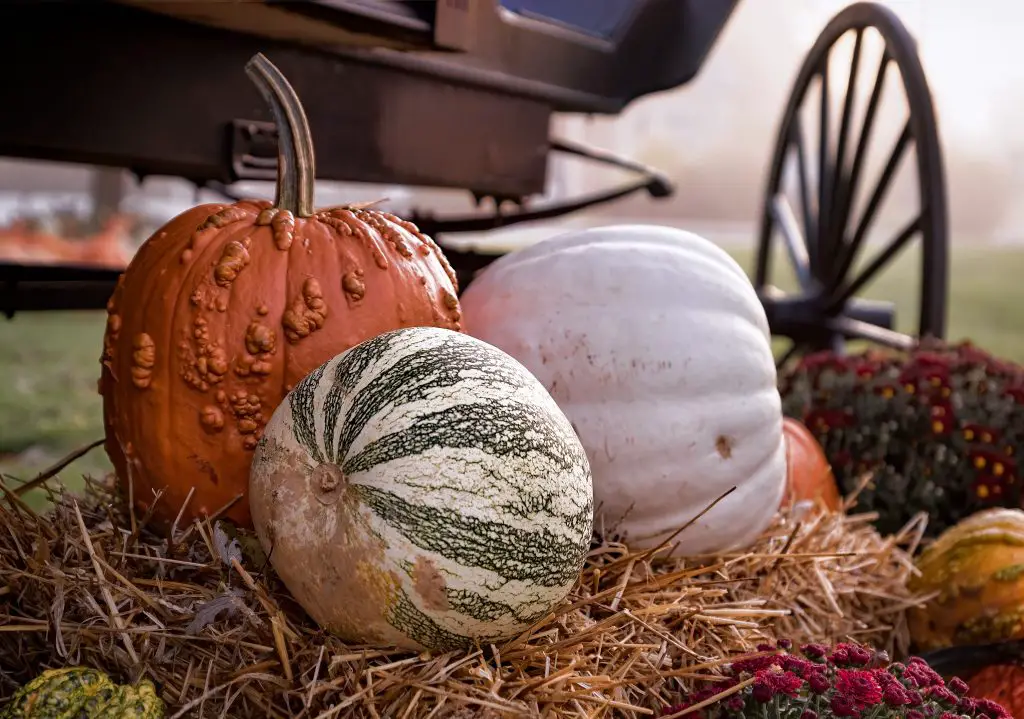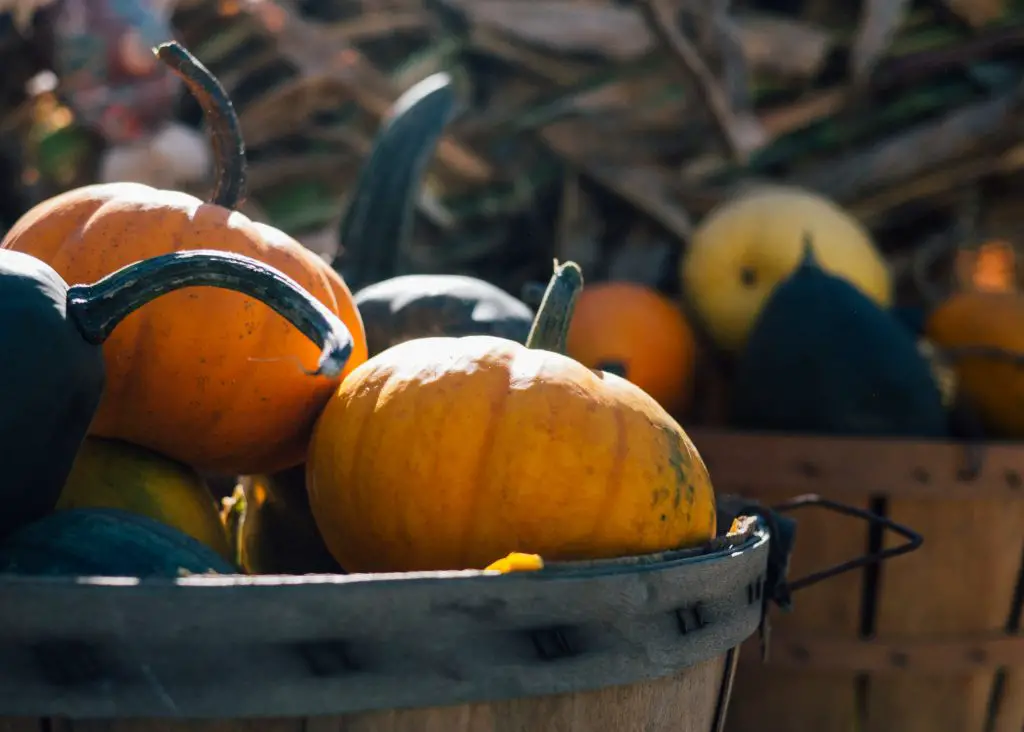The question is often asked – Can I plant seeds from the Pumpkin I bought at the store? and the answer is yes. If the Pumpkin was produced from an heirloom Pumpkin seed, it will happily grow in your garden and produce a similar fruit to the one purchased. However, if the Pumpkin was grown from a hybrid seed, which is impossible to tell by looking at it, there is around a 5% chance that the seed planted will produce a fruit that is the same as the one it came from.
A hybrid Pumpkin seed is produced by crossing two different varieties of Pumpkins. This is designed to create specific traits, such as larger fruit or better disease resistance within a plant. The first generation of a hybridized plant, known as F1, tends to grow better and produce higher yields than the parent varieties.
However, these seeds produced by F1 plants are genetically unstable and will not be true-to-type, ie they will have different characteristics. They are also likely to be considerably less vigorous than the parent plant and have fewer of the desired characteristics. Heirloom seeds, on the other hand are from old varieties that have been handed down generations and will produce fruit of consistent quality in successive generations. To learn more about the differences between Hybrid, Heirloom and genetically modified seeds go to https://planyourpatch.com/what-is-an-f1-hybrid-seed/.
If you would like to buy Heirloom seeds there are a number of online seed companies that specialize in Heirloom Seeds. Of the ones that I have come across Seeds Now is the cheapest and they have a fairly extensive range. Additionally, if it is not clear whether the seeds are a hybrid or heirloom variety try visiting our vegetable database for more information as there is information on hundreds of different varieties.
Can You Plant Pumpkin Seeds Straight From A Store Bought The Pumpkin?
It is generally not a good idea to take a seed directly from a Pumpkin and plant it straight into the ground. The reason for this is that not all seeds are immediately ready for germination, once removed from the fruit.
In the case of Pumpkin seeds, they contain growth inhibitors that prevent the seed from germinating immediately, when it is exposed to moist conditions. This is important, as it ensures that there is a higher probability that seed will produce a plant, in conditions that are most favorable to its survival. It also prevents the seeds from germinating when inside the moist interior of the Pumpkin.
To plant seeds immediately, it is recommended that the seeds are washed to remove any Pumpkin pulp or flesh, which will help to remove any seed inhibitors on the surface. Dry the seed thoroughly, then scratch the sides and end of the seed with sandpaper. This will weaken the outer shell of the seed and will allow the seed to more readily absorb water and allow the seedling to emerge from the cell more readily.

How to Grow Pumpkin
All varieties of Pumpkins are frost tender plants that require warm conditions to thrive. They require a well-drained soil and plenty of organic matter to produce a large crop. The ideal pH for the soil is around 6.0-6.8, to learn how to test the pH of the soil and adjust it go to https://planyourpatch.com/why-is-ph-important-in-soil/.
Plant pumpkin seeds directly into the soil, 1 inch (2-3 cms) below the surface, in Spring after the risk of frost has passed, or they can be established in modular trays undercover, approximately 4 weeks before the first frost. If planting in modular trays the seedlings will take 4 to 6 weeks before they are large enough to be planted out. At this stage, the seedlings are typically 10 cm (4 inches) tall.
It is generally recommended that Pumpkins be planted out earlier in the growing season, to allow time for the fruit to ripen, and subsequent crops to be established as early, in Autumn as possible, to ensure an ongoing food supply through the Winter.
However, if you live in a region with particularly cold winters or you want to start the plants off early it is best to use a heated propagation tray. The heated propagation trays provide the ideal growing conditions for germinating seedlings and they are not overly expensive to purchase. The one we recommend is the iPower Heating Seed Starter Germination Kit, shown in the picture below largely because it has a vented humidity dome. Click on the link to see the current price on Amazon.

Pumpkins will spread along the ground but can be encouraged to climb trellis if space becomes an issue. Corn and Pole Beans can be grown in the same space as the Pumpkins to maximize a garden’s output. The learn more about climbing beans go to https://planyourpatch.com/what-is-difference-between-dwarf-beans-and-climbing-beans/.
It is common for pumpkins to get started to turn white later in the season. This whitening is due to the formation of powdery mildew. This generally does not have a significant impact on the productivity of the plant but is a little unsightly. For more information on how to treat powdery pumpkin go to https://planyourpatch.com/why-are-my-pumpkin-leaves-turning-white/.

The fruits can be harvested when they begin to change color, and the foliage begins to die back. Care should be taken when harvesting to leave the stem on the Pumpkin.
How to Store Pumpkins
Pumpkins can be stored for up to 12 months in a cool dry area, around 4°C (40°F), is ideal. However, Pumpkins will generally last for an extended period, even if no real effort is made to protect the fruit, provided the stem on the Pumpkin remains intact. I personally leave them on the back deck undercover for months without significant issues.

The reason for leaving the stork is important because removing it provides an access point for bacteria to get into the fruit. It is ideal to leave around 5cm (2-3 inches) of stem attached. If the stem is damaged during the harvest, it is not the end of the world; it will still be a fair while before going off. When selecting Pumpkins to eat, use those with damaged storks first.
Another thing that can be done to lengthen the shelf life, is to lie the Pumpkin on its side. This will prevent there being an opportunity for water to pool around the stork for an extended period of time.
Related Articles
Why are my pumpkin leaves turning white?
How Much Space Do You Need Between Pumpkin Plants?
How Many Pumpkins Are Produced Per Plant? And How Big Are They?
Do Pumpkins Grow Back Every Year?
Can Pumpkin Be Grown In A Pot? (And Here Is How To Do It)
Are Pumpkins Berries? If So, Why?
